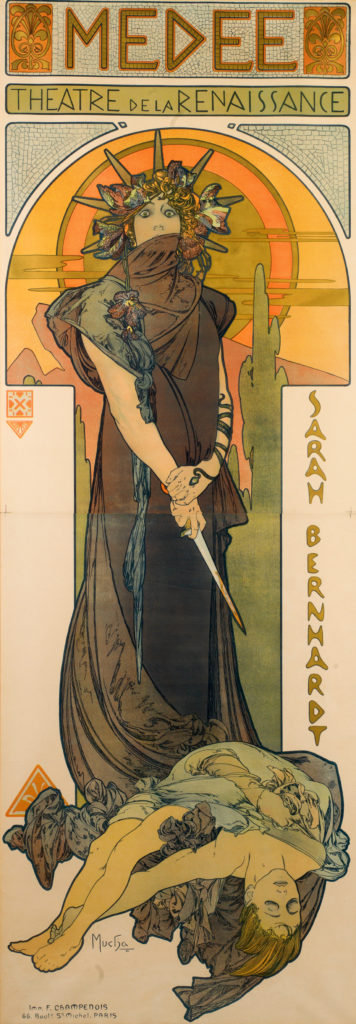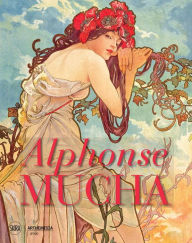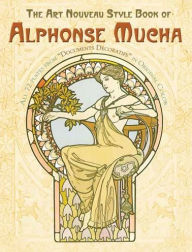Art in NYC: Art Nouveau / Nouvelle Femme Posters by Alphonse Mucha at Poster House
The recently opened museum of posters presents Alfonse Mucha: Art Nouveau / Nouvelle Femme, its inaugural exhibition of posters and decorative objects; on view from June 20-October 6, 2019
![Art Nouveau posters at Poster House by Alphonse Mucha,Sarah Bernhardt/La Plume [1896]](https://www.arts-ny.com/wp-content/uploads/2019/08/Alphonse-Mucha-Sarah-Bernhardt-PosterHouse-220x300.jpg)
The exhibition of Mucha’s major works presents his art in two galleries. One gallery is dedicated to the advertising posters, which include designs for theaters, cookie brands, the beer-producing region, and bicycles and spirit companies among others. The second gallery shows the posters made for decorative purposes.
![Art Nouveau posters at Poster House by Alphonse Mucha Bières de la Meuse [1897] Lithograph](https://www.arts-ny.com/wp-content/uploads/2019/08/Alphonse-Mucha-Biere-poster-196x300.jpg)
Stay in the know about future events and offers by subscribing to ARTS-NY newsletter Subscribe

The work for the Viennese theater stopped short when the fire had destroyed the building and led Mucha to look for jobs in lettering and decorative art. He found a rich sponsor Count Belasi who for a limited time supported his studies in Munich and later in Paris. Left on his own in Paris, Mucha earned a living as an illustrator and a designer at the printing house bringing with him a female-centered style of the Viennese art.
While working at the printing house on that fateful Christmas day, a request for a poster came from Bernhardt and started a new chapter in Mucha’s career. Bernhardt was very pleased with Mucha’s poster and signed a contract with him for six years. The collaboration brought to life the famous posters for the major theater productions starting Sarah Bernhardt in Medee, La Tosca, and Hamlet. Orders from other companies followed.
Mucha’s skills in lettering came in handy for the development of his decorative style. Imitating the calligraphy of the handwritten texts going back to Ancient Rome and Biblical time, he drew the letters in a style appropriate for the epoch and place. The technique of Hebrew letter stylizing, for example, is vividly displayed in the poster for La Samaritaine play written by E. Rostand for Bernhardt who loved to portray Jewish characters on stage.

Between 1996 and 1902, Mucha used his belief in Nouvelle Femme and the image of confident and independent women for the advertisements of consumer products from cookies to cigarette paper. His clever observation that female beauty will catch the eyes regardless of the subject of the promotion was hugely successful and widely used since then. Employing the rich elements of the art nouveau in his posters with sumptuous decorations and only fleeting mention of the product in question was a bold move at the time. Mucha was also the first to introduce a celebrity endorsement for products. One of the posters for the Lefevre-Utile (LU) cookie brand with a beautiful image of Bernhardt in a costume of La Princesse Lointaine, has her signed testimonial “I haven’t found anything better than a little LU – oh, yes, two little LU”. The abbreviation LU was also suggested by Mucha, which is still in use. In the words of the exhibition curators “A design revolution was underway.”
![Art Nouveau posters at Poster House by Alphonse Mucha Job [1896] Lithograph](https://www.arts-ny.com/wp-content/uploads/2019/08/Alphonse-Mucha-Job-poster-239x300.jpg)
The Poster House opened its doors in June of this year. This is the first museum dedicated to poster art in the United States. As posters democratized art and brought it to the wider public, the Poster House is striving to exhibit a diversity of styles to educate its visitors about the historical and current trends.
Alphonse Mucha: Art Nouveau / Nouvelle Femme is on view until October 6, 2019.
Stay in the know about future events and offers by subscribing to ARTS-NY newsletter Subscribe
Dates: June 20 – October 6, 2019
